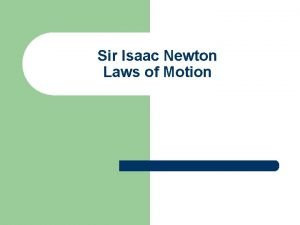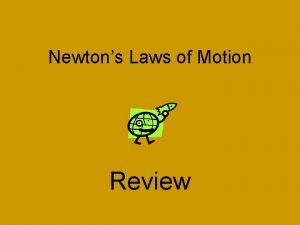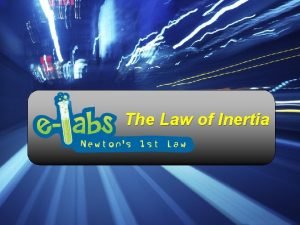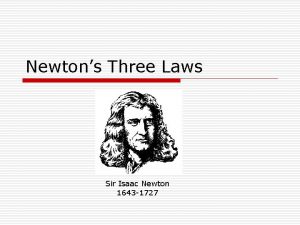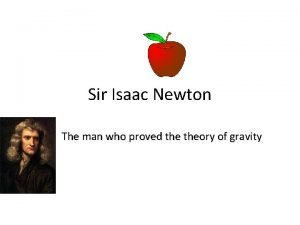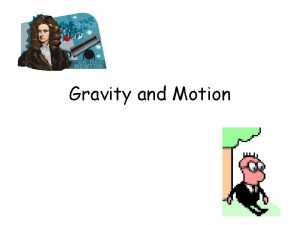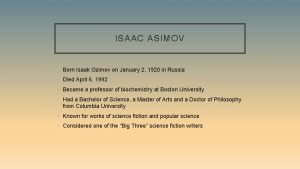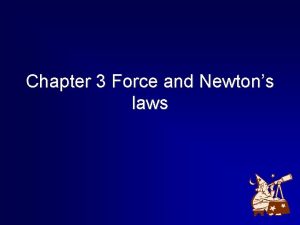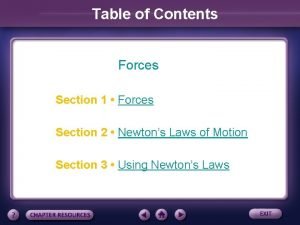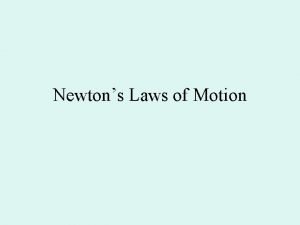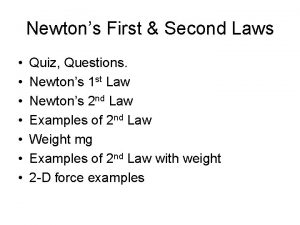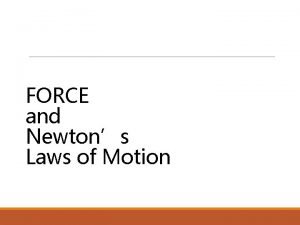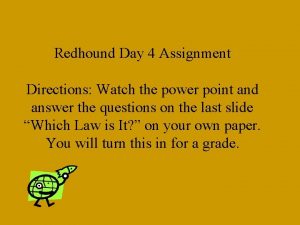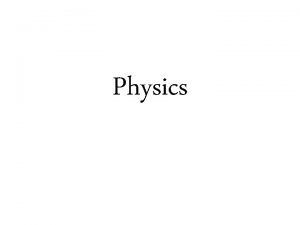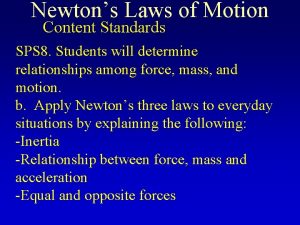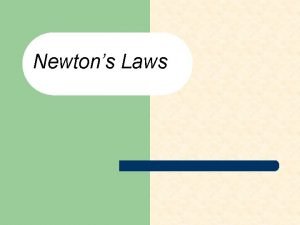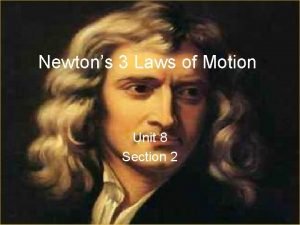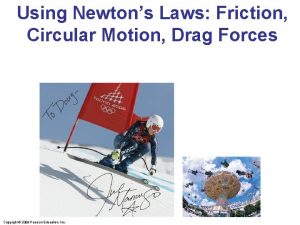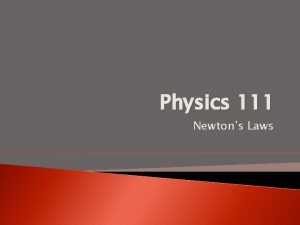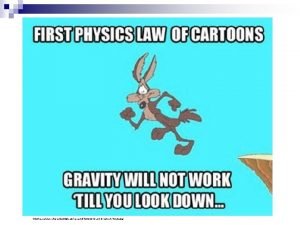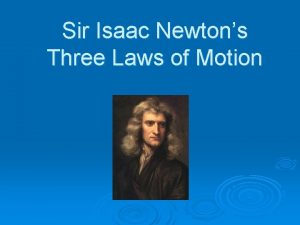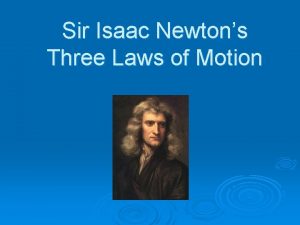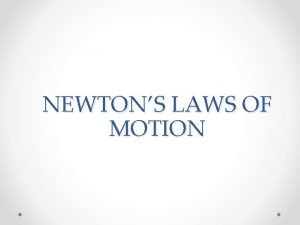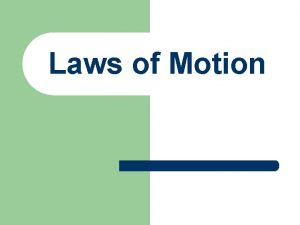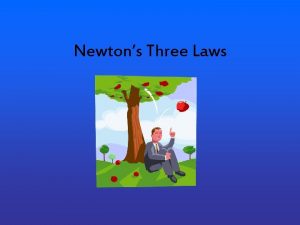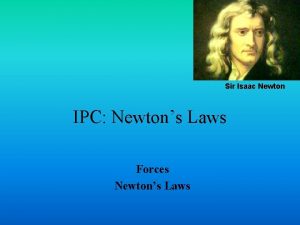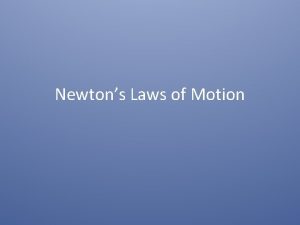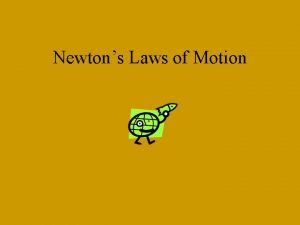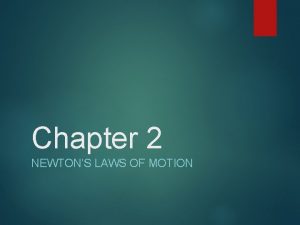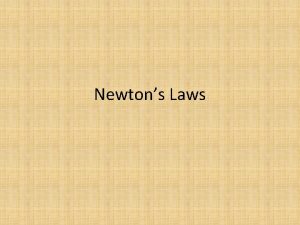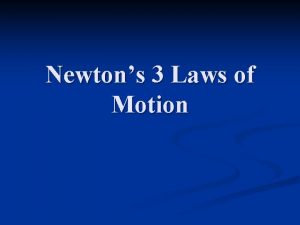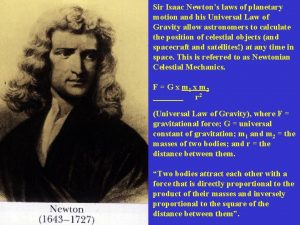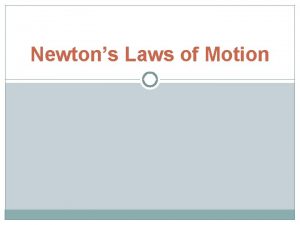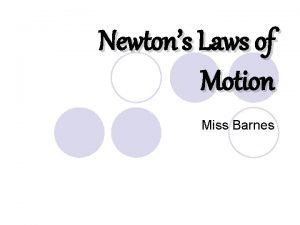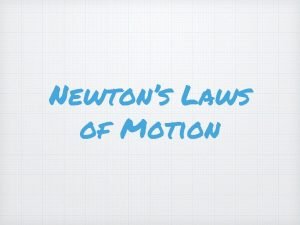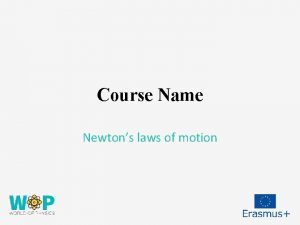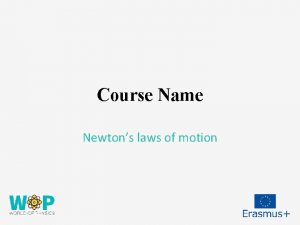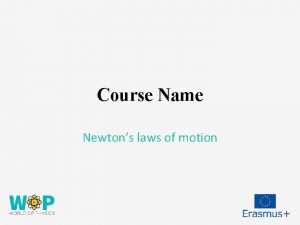Chapter 4 Newtons Laws of Motion Sir Isaac


































- Slides: 34

Chapter 4 Newton’s Laws of Motion

Sir Isaac Newton Philosophiae Naturalis Principia Mathematica (1687) Opticks (1704) "Nature and nature's laws lay hid in night; God said 'Let Newton be' and all was light. "

Newton’s Three Laws Inertia: “Every body continues in its state of rest, or of uniform motion in a straight line, unless it is compelled to change that state by a force impressed on it. ” Force, Mass, Acceleration (F=ma): “The change in motion is proportional to the motive force impressed; and is made in the direction of the right line in which that force is impressed. ” “Action = Reaction”: “To every action there is always opposed an equal reaction; or, the mutual actions of two bodies are always equal, and directed to contrary parts. ”

Newton’s Law Summary 1. Velocity is zero or constant when net force is zero. 2. F=ma 3. Action = Reaction (in opposite direction)

Net Force Net force (or total force) is the sum of all the forces applied to an object. For example, if there are three people, A, B and C pushing the crazy kid. The net force on him is:

First Law and Net Force The First Law deals with cases when there is no net force “Every body continues in its state of rest, rest or of uniform motion in a straight line, unless it is compelled to change that state by a force impressed on it. ”

Puck on ice Ice has very little friction (so no net force), so the inertia keeps the puck moving once it is set in motion.

Mass or Inertia is the tendency of an object to remain at rest or in motion with constant speed along a straight line. Mass (m) is the quantitative measure of inertia. Mass is the property of an object that measures how hard it is to change its motion. Units: kg

Mass vs. Weight Mass is an intrinsic property of an object. A rock has same mass whether it is on the moon or on Earth. Mass does not change Weight is the force exerted on an object by gravity: W=mg This is different depending upon the strength of the gravitational force. You weigh less on the Moon than on Earth.

Example What is the weight of a man of mass 70 kg on Earth? Weight is measured in N. (Pound: 1 lb = 4. 448 N)

Same mass, different weight

Newton’s 1 st Law There are many forces act on the plane, including weight (gravity), drag (air resistance), the thrust of the engine, and the lift of the wings. At some point the velocity of the plane is constant. At this time, the total (or net) force on the plane: lift 1. is pointing upward 2. is pointing downward 3. is pointing forward 4. is pointing backward correct 5. is zero drag thrust weight

Newton’s 1 st Law Newton's first law states that if no net force acts on an object, then the velocity of the object remains constant Since the velocity is constant, the total force on the plane must be zero, according to Newton's first lift law. drag thrust weight

Newton’s Second Law F = ma Unit: N (Newton) Deals with the effect of a non-zero net force Non-zero net force causes acceleration

Some Math What does the vector symbol mean? F = ma applies to each component independently

F means NET FORCE!!! FORCE The F in F = ma is the net force on the object. If you are careful, you may write instead: Fnet = ma Always remember to find the net force first!

Simple Examples: Find a F = 200 N m = 10 kg F = 150 N

Find the magnitude of a

When Fnet is non-zero When Fnet ≠ 0, 0 since F=ma, we have a≠ 0 No net force, no acceleration. Net force leads to acceleration. If an object is accelerating, accelerating there must be a non -zero net force

Example The mass of m = 2 kg is accelerating upward at 4 m/s 2. Find the tension.

Example The mass of m = 2 kg is accelerating downward at 4 m/s 2. Find the tension.

T-mg or mg-T ? In non-vector notation, we usually assume the variable a represents the magnitude of the acceleration, and is therefore positive whether it is up or down. In other words, unless stated otherwise, we will not use the up/positive, down/negative convention. With this new convention, whenever you have opposing forces, the forces pointing in the same direction as a comes first, minus the forces in the opposite direction as a.

T-mg or mg-T ? (same direction) - (opposite direction) = ma

Two forces F 1 = 200 N a m = 10 kg F 2 = 350 N

Newton’s Third Law For every force, there is an equal and opposite force every “action” has a “back-reaction” these are precisely equal and precisely opposite

Newton’s Third Law You cannot push without being pushed back just as hard In tug-of-war, each side experiences the same force (opposite direction) When you push on a brick wall, it pushes back on you!

Force Pairs Illustrated Force on box by person Force on floor by box Force on person by box Force on box by floor Force on person Force on floor by person by floor Not shown are the forces of gravity and the associated floor forces

Don’t all forces then cancel? How does anything ever move (accelerate) if every force has an opposing pair? Action and reaction force act on different objects. Force on box by person Net Force on box by floor

Normal Force from a solid surface (e. g. wall, ground) providing support for an object. “Normal” means “perpendicular”, Normal Force is always perpendicular to the solid surface. Notations: FN, Fn, N or n

Example of Normal Force Suppose the elevator is not accelerating. m=70 kg, what does the scale read?

Example of Normal Force 2 Suppose the elevator is accelerating up. m=70 kg, a=5 m/s 2

Example of Normal Force 3 Suppose the elevator is accelerating down. m=70 kg, a=5 m/s 2

Be careful with the normal force

What is Fn now?
 Newton's laws name
Newton's laws name Newtons laws od motion
Newtons laws od motion Section 2 newtons laws of motion
Section 2 newtons laws of motion Newton's 3 laws of motion
Newton's 3 laws of motion Newton's 3 law
Newton's 3 law F=ma
F=ma Inertia in life
Inertia in life Teacher rice edu sir isaac newton
Teacher rice edu sir isaac newton Oppisite of sir
Oppisite of sir Isaac chewed pen
Isaac chewed pen Sir isaac asimov
Sir isaac asimov Newtons laws
Newtons laws Universal gravitation law
Universal gravitation law Newtons 3 laws
Newtons 3 laws Third law of newton
Third law of newton Section 3 using newtons laws
Section 3 using newtons laws Section 1 forces
Section 1 forces Section 3 using newtons laws
Section 3 using newtons laws Newton's st law
Newton's st law Newton's first and second law quiz
Newton's first and second law quiz Newton's 3rd law example
Newton's 3rd law example Newtons three law
Newtons three law Newton's laws of motion
Newton's laws of motion Newton's laws of motion
Newton's laws of motion Newton's law of motion
Newton's law of motion When the pellet fired into the spiral tube
When the pellet fired into the spiral tube Newton's 3 law of motion
Newton's 3 law of motion Newton's first law of motion examples
Newton's first law of motion examples Newtons laws
Newtons laws Ethan is dragging a bag of grass
Ethan is dragging a bag of grass Newtons 3 rd law of motion
Newtons 3 rd law of motion Newtons 3 rd law of motion
Newtons 3 rd law of motion Chapter 8 ask newton
Chapter 8 ask newton Rd law
Rd law Newton's second law meme
Newton's second law meme




